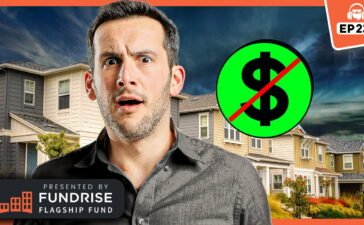What Lawmakers Must Do to Support Investors and Boost Housing Supply

There’s a critical lack of affordable housing. This housing shortage began following the 2008 financial crisis and worsened during the pandemic, and now, not enough homes have been built to meet current demand. Inventory is slowly rising in Q2, which is helpful, but more inventory alone doesn’t solve the problem.
The government has plans to help create more affordable housing inventory and keep large-scale investors from taking homes away from middle-income Americans. The White House released a budget in March that included plans to support Biden’s Housing Supply Action Plan. Items like significant tax credits for first-time homebuyers and for homeowners who sell their starter homes were created to directly reward and incentivize consumers to move.
Incentives like local grants, the Low-Income Housing Tax Credit, and the proposed New Neighborhood Homes Tax Credit could offer financial breaks to developers and investors who are able to navigate these government programs and procure funding for their projects.
Lawmakers are making it clear that extremely low-income and affordable rental housing are major priorities for funding and legislation. Again, if they get off the ground, these could be helpful initiatives to increase a specific category of housing inventory, but what else is missing?
Somewhere between the institutional investor that owns 1,000+ properties and the nonprofits trying to support low-income communities with government programs is the independent investor. These local mom-and-pop solopreneurs and small business owners actively rehab homes in their local neighborhoods—often taking on the vacant, abandoned, and distressed inventory that won’t qualify for traditional financing and projects that are likely beyond the scope of possibility for an average homebuyer who may want to take on a fixer-upper.
This independent investor plays the role of a housing provider. But do lawmakers know they exist? Or what impact do single-family investors make by bringing affordable inventory back to the market for the average middle-income homebuyer?
Affordable housing legislation will need votes to pass, and the upcoming presidential election will divert and splinter attention. But the independent investor will keep moving. Keep rehabbing—flipping and renting could make an exponential impact on housing inventory with a little help.
Legislative Factors Influencing Independent Investors
Lawmakers don’t acknowledge the role of the independent investor
In the current housing landscape, the prevalent narrative that paints independent investors as major contributors to the hoarding of housing and the consequential surge in prices is a gross oversimplification, and a more in-depth understanding reveals a nuanced story.
Large investors and private equity firms who own more than 1,000 single-family residences represent a small percentage of overall ownership. In fact, most institutional investors have been on the sidelines because of high financing costs and have shifted strategies. SFR players who own approximately 3% of SFRs are buying existing portfolios from smaller investors and focusing more on the build to rent space.
Yet bills like the most recent Affordable Housing and Homeownership Protection Act are aiming to tax real estate investors on every SFR purchase. The bill defines large investors as those who own between 25 and 100 homes, and “giant” investors are those who own 100+ SFRs. These investors would pay a tax of 3-5% of the purchase price on each individual property, every tax year. A 1% tax would be leveraged on “medium” investors with 15 properties.
This is just one very recent example that shows that policymakers have not met or understood the role of the independent investor as a housing provider. Investors who rehab and own rental property are accustomed to navigating existing and proposed legislation around tenant bills, squatter’s rights, and landlord laws. Large-scale institutional investors will just shift around priorities until the rental market makes sense for them financially to reenter.
And yet, the independent investor gets somewhat tossed into the mix, included in headlines and negative conversations about Wall Street taking over Main Street. They are criticized for not only competing with the average homebuyer and driving the market in the wrong direction but are also never seen in a positive light for the good work that they do. A spotlight would be nice, even though they aren’t asking for one.
State and local government roadblocks
When it comes to zoning, land use, and building requirements, not all states are the same, and neither are the numerous individual counties and cities. The federal government is encouraging local governments to reevaluate outdated zoning and building restrictions to open up opportunities for new construction and rehabbing properties.
There are often limits on square footage and density or allowing manufactured homes and accessory dwelling units in local communities. Legislative focus specifically targeted to help single-family investors could impact these investors’ ability to rehab, add additional units, and create more housing.
Incentives and grants from local governments designed for the single-family investor could bolster inventory quickly, with the potential for independent investors to overhaul entire streets of uninhabitable homes. New construction timelines can be 18 months for a single property, and the sale of existing inventory is just an exchange of a home, not an addition.
For now, the independent investor must stay on top of local legislation and either seize opportunities with zoning, land use, and building restrictions or avoid the pitfalls. Either way, there are nearly 15 million vacant homes in the U.S., as well as a vast inventory of aging homes owned by boomers that will require major renovations to become livable for a new buyer. These are prime projects for the independent investor who can bring these properties back to market.
The Mortgage Rate Problem
Mortgage rates will obviously continue to be a factor that impacts the entire housing market in 2024 and beyond—no surprise there. The fact is that headlines about mortgage rates do impact homebuyers and sellers and cause them to act or not act, often because of fear.
Predictions at the beginning of the year had the Federal Reserve lowering the federal funds rate at least once or twice during 2024, and as of now, it appears those plans have been pushed out. This means homebuyers and sellers who need to move are embracing mortgage rates, sales prices are up, and inventory is still tight.
For investors, the mortgage rate story is the same from last year to this year, and they plan to keep rehabbing homes and adding to their rental portfolios. Because they have access to alternative capital or equity from other properties, the actual mortgage rate does not prevent investors from doing their jobs. Although it may hinder some, they continue to add to housing inventory alongside new construction without much attention.
Final Thoughts
At New Western, we serve over 200,000 investors who buy rehab properties through our marketplace. These are the local, independent investors who could benefit from access to financing and help with navigating complex regulations.
A November 2023 survey of nearly 1,300 New Western investors reveals a positive outlook for 2024 and the potential for impact on affordable housing inventory. Here are some highlights:
- Growth is expected: Over half of investors surveyed have a strong sense of optimism for their business growth in 2024. And they anticipate a 25% increase in their rehab business over the next year.
- Acquisition plans: About 80% of investors have concrete plans to acquire properties, aiming to purchase between one and five properties in 2024.
- Focus on vacant or uninhabitable properties: Most investors are concentrating on properties that are either vacant or uninhabitable.
- Pricing trends: Despite targeting properties that require considerable investment and renovation, a significant 64% of investors report being able to sell their properties at or above the asking price and are in line with the middle-income buyer’s budget.
While independent investors will continue to grow their businesses in 2024 and rehab uninhabitable properties, innovative policy measures could help support and expand their impact, especially in creating affordable housing options.
This article is presented by New Western

New Western makes it easy to buy an investment property.
As the largest private source of investment properties in the nation, New Western buys a home every 13 minutes for our marketplace of more than 150,000 investors looking to rehab houses. Investors have access to a large volume of inventory and to our licensed agents who are local experts in over 50 markets across the country.
Join our marketplace for free.
Note By BiggerPockets: These are opinions written by the author and do not necessarily represent the opinions of BiggerPockets.









